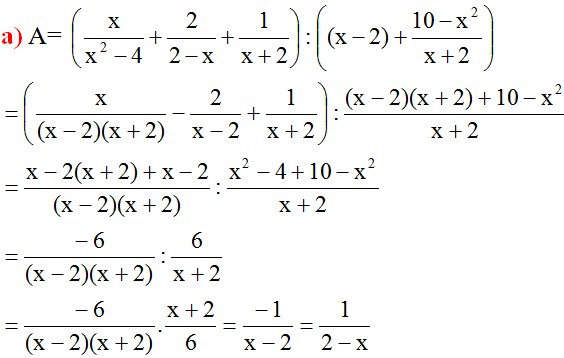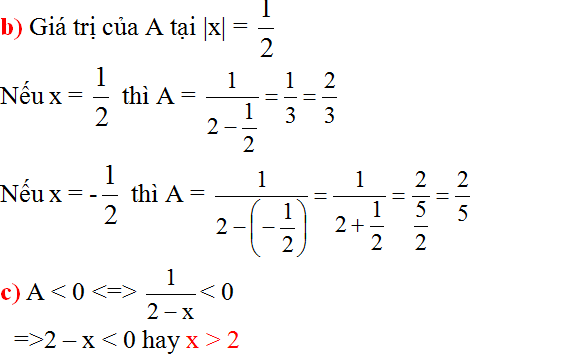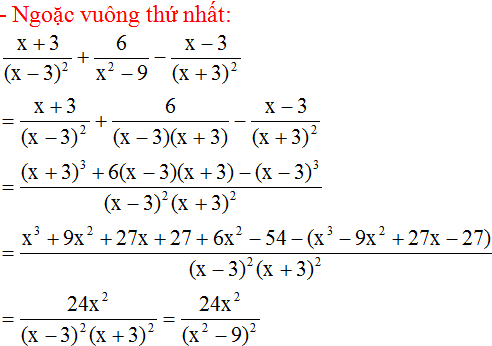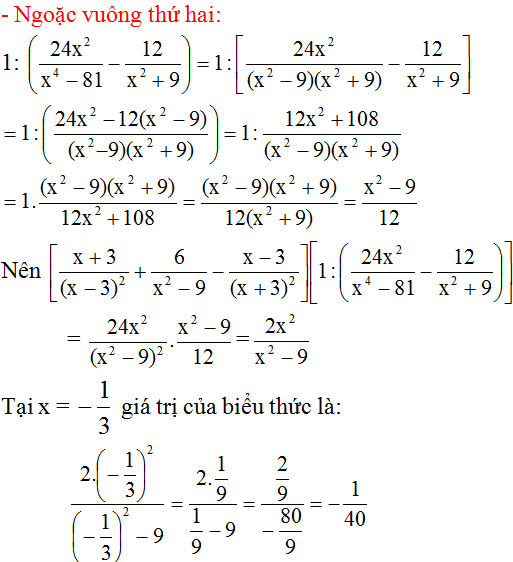Hãy nhập câu hỏi của bạn vào đây, nếu là tài khoản VIP, bạn sẽ được ưu tiên trả lời.

a,ĐK: \(\hept{\begin{cases}x\ne0\\x\ne\pm3\end{cases}}\)
b, \(A=\left(\frac{9}{x\left(x-3\right)\left(x+3\right)}+\frac{1}{x+3}\right):\left(\frac{x-3}{x\left(x+3\right)}-\frac{x}{3\left(x+3\right)}\right)\)
\(=\frac{9+x\left(x-3\right)}{x\left(x-3\right)\left(x+3\right)}:\frac{3\left(x-3\right)-x^2}{3x\left(x+3\right)}\)
\(=\frac{x^2-3x+9}{x\left(x-3\right)\left(x+3\right)}.\frac{3x\left(x+3\right)}{-x^2+3x-9}=\frac{-3}{x-3}\)
c, Với x = 4 thỏa mãn ĐKXĐ thì
\(A=\frac{-3}{4-3}=-3\)
d, \(A\in Z\Rightarrow-3⋮\left(x-3\right)\)
\(\Rightarrow x-3\inƯ\left(-3\right)=\left\{-3;-1;1;3\right\}\Rightarrow x\in\left\{0;2;4;6\right\}\)
Mà \(x\ne0\Rightarrow x\in\left\{2;4;6\right\}\)

Lời giải của bạn Nhật Linh đúng rồi, tuy nhiên cần thêm điều kiện để A có nghĩa: \(x\ne\pm2\)

a) \(ĐKXĐ:\hept{\begin{cases}x\ne\pm2\\x\ne-3\end{cases}}\)
b) \(P=1+\frac{x+3}{x^2+5x+6}\div\left(\frac{8x^2}{4x^3-8x^2}-\frac{3x}{3x^2-12}-\frac{1}{x+2}\right)\)
\(\Leftrightarrow P=1+\frac{x+3}{\left(x+3\right)\left(x+2\right)}:\left(\frac{8x^2}{4x^2\left(x-2\right)}-\frac{3x}{3\left(x^2-4\right)}-\frac{1}{x+2}\right)\)
\(\Leftrightarrow P=1+\frac{1}{x+2}:\left(\frac{2}{x-2}-\frac{x}{\left(x-2\right)\left(x+2\right)}-\frac{1}{x+2}\right)\)
\(\Leftrightarrow P=1+\frac{1}{x+2}:\frac{2x+4-x-x+2}{\left(x-2\right)\left(x+2\right)}\)
\(\Leftrightarrow P=1+\frac{1}{x+2}:\frac{6}{\left(x-2\right)\left(x+2\right)}\)
\(\Leftrightarrow P=1+\frac{\left(x-2\right)\left(x+2\right)}{6\left(x+2\right)}\)
\(\Leftrightarrow P=1+\frac{x-2}{6}\)
\(\Leftrightarrow P=\frac{x+4}{6}\)
c) Để P = 0
\(\Leftrightarrow\frac{x+4}{6}=0\)
\(\Leftrightarrow x+4=0\)
\(\Leftrightarrow x=-4\)
Để P = 1
\(\Leftrightarrow\frac{x+4}{6}=1\)
\(\Leftrightarrow x+4=6\)
\(\Leftrightarrow x=2\)
d) Để P > 0
\(\Leftrightarrow\frac{x+4}{6}>0\)
\(\Leftrightarrow x+4>0\)(Vì 6>0)
\(\Leftrightarrow x>-4\)

a) Đk: x > 0 và x khác +-1
Ta có: A = \(\left(\frac{x+1}{x}-\frac{1}{1-x}-\frac{x^2-2}{x^2-x}\right):\frac{x^2+x}{x^2-2x+1}\)
A = \(\left[\frac{\left(x-1\right)\left(x+1\right)+x-x^2+2}{x\left(x-1\right)}\right]:\frac{x\left(x+1\right)}{\left(x-1\right)^2}\)
A = \(\frac{x^2-1+x-x^2+2}{x\left(x-1\right)}\cdot\frac{\left(x-1\right)^2}{x\left(x+1\right)}\)
A = \(\frac{x+1}{x}\cdot\frac{x-1}{x\left(x+1\right)}=\frac{x-1}{x^2}\)
b) Ta có: A = \(\frac{x-1}{x^2}=\frac{1}{x}-\frac{1}{x^2}=-\left(\frac{1}{x^2}-\frac{1}{x}+\frac{1}{4}\right)+\frac{1}{4}=-\left(\frac{1}{x}-\frac{1}{2}\right)^2+\frac{1}{4}\le\frac{1}{4}\forall x\)
Dấu "=" xảy ra <=> 1/x - 1/2 = 0 <=> x = 2 (tm)
Vậy MaxA = 1/4 <=> x = 2

\(ĐKXĐ:\hept{\begin{cases}x\ne\pm2\\x\ne0\end{cases}}\)
a) \(P=\left(\frac{x^2}{x^3-4x}+\frac{6}{6-3x}+\frac{1}{x+2}\right):\left(x-2+\frac{10-x^2}{x+2}\right)\)
\(\Leftrightarrow P=\left(\frac{x^2}{x\left(x-2\right)\left(x+2\right)}-\frac{6}{3\left(x-2\right)}+\frac{1}{x+2}\right):\frac{x^2-4+10-x^2}{x-2}\)
\(\Leftrightarrow P=\frac{x^2-2x\left(x+2\right)+x\left(x-2\right)}{x\left(x-2\right)\left(x+2\right)}:\frac{6}{x-2}\)
\(\Leftrightarrow P=\frac{x^2-2x^2-4x+x^2-2x}{x\left(x-2\right)\left(x+2\right)}\cdot\frac{x-2}{6}\)
\(\Leftrightarrow P=\frac{-6x}{6x\left(x+2\right)}\)
\(\Leftrightarrow P=\frac{-1}{x+2}\)
b) Khi \(\left|x\right|=\frac{3}{4}\)
\(\Leftrightarrow\orbr{\begin{cases}x=\frac{3}{4}\\x=-\frac{3}{4}\end{cases}}\)
\(\Leftrightarrow\orbr{\begin{cases}P=-\frac{1}{\frac{3}{4}+2}=-\frac{4}{11}\\P=-\frac{1}{-\frac{3}{4}+2}=-\frac{4}{5}\end{cases}}\)
c) Để P = 7
\(\Leftrightarrow-\frac{1}{x+2}=7\)
\(\Leftrightarrow7\left(x+2\right)=-1\)
\(\Leftrightarrow7x+14=-1\)
\(\Leftrightarrow7x=-15\)
\(\Leftrightarrow x=-\frac{15}{7}\)
Vậy để \(P=7\Leftrightarrow x=-\frac{15}{7}\)
d) Để \(P\inℤ\)
\(\Leftrightarrow1⋮x+2\)
\(\Leftrightarrow x+2\inƯ\left(1\right)=\left\{\pm1\right\}\)
\(\Leftrightarrow x\in\left\{-3;-1\right\}\)
Vậy để \(P\inℤ\Leftrightarrow x\in\left\{-3;-1\right\}\)








